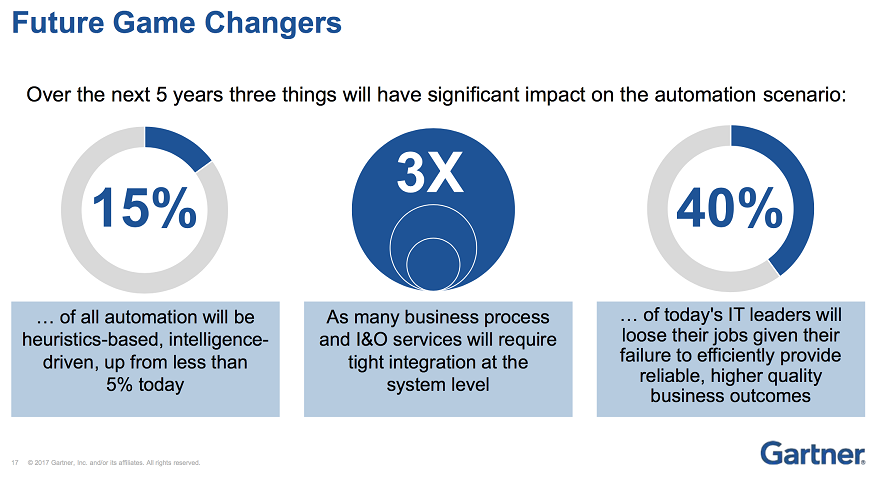3 Key Takeaways from the Gartner I&O Conference

BigPanda exhibited and moderated a customer success panel at Gartner’s big IT Infrastructure, Operations Management & Data Center show in Las Vegas last month. The Gartner I&O Conference is action-packed, so it’s taken me awhile to digest all the great information and insights I gathered there.
Gartner’s influence in the enterprise IT operations market is undisputed. This event remains one of the most important gatherings for senior IT Operations execs in North America, even though other shows are increasing in importance (AWS re:Invent and ServiceNow’s Knowledge come to mind).
Ultimately I’m struck with three primary takeaways from the conference.
Takeaway #1: Gap Widening between Tech “Haves” & “Have-nots”
The content of the keynote and some of the far-reaching “future-prediction” sessions left me wondering how much progress we are actually making as an industry.
We certainly have a ton of new technology – from IoT to containers to artificial intelligence. I’m sure that there are interesting things happening in the networking and storage spaces as well. But how much real progress are we making in helping our enterprises take advantage of the opportunities, and perhaps more importantly, to address the challenges that we face today?
Gartner leaders repeated a seemingly ceaseless call to “be more strategic”, “enable the business”, and “drive down the time to value” for new technologies. Those are all great IT objectives, but haven’t we been working on them already? I guess we haven’t been making enough progress.
Digital Transformation is the tremendous shift that businesses are addressing now. This is really an assault on the old way of creating value for our customers. Is your IT team acting as a real partner enabling this new way of doing business?
 Certainly there are many enterprises who are making this shift; others have already completed it. IT is a key enabler. However, there are still far too many enterprises that are stuck still managing static environments and infrastructures. There are far too many enterprises stuck with fragile code bases that take way too long to update. These unfortunate enterprises are likely the heavy favorites to be acquired, taken private, or go out of business as they miss their sales targets. Competitors that are better positioned to respond to Digital Transformation will do a better job of meeting the needs of fickle and demanding customers.
Certainly there are many enterprises who are making this shift; others have already completed it. IT is a key enabler. However, there are still far too many enterprises that are stuck still managing static environments and infrastructures. There are far too many enterprises stuck with fragile code bases that take way too long to update. These unfortunate enterprises are likely the heavy favorites to be acquired, taken private, or go out of business as they miss their sales targets. Competitors that are better positioned to respond to Digital Transformation will do a better job of meeting the needs of fickle and demanding customers.
This is the first takeaway: the gap between the digital technology “haves” and “have-nots” is widening, and the consequences for the “have-not” enterprises could be drastic.
Takeaway #2: Artificial Intelligence Arrives for Enterprise IT
As an industry we’ve tried many techniques over the years to improve IT’s ability to deliver for customers, both internal and external. Some of these efforts have been more successful than others, but the major ITOM technologies (i.e. tools that help IT run itself) have continued to evolve and improve over time. The ability of enterprise IT leaders to keep up with the advancements in technology over the last decade has been impressive.
Earlier this year, Gartner introduced a new term called AIOps. Its definition morphed over the course of 2017, and we at BigPanda expect it to evolve quite a bit more in 2018 and beyond. However, the basic promise of applying advanced computing techniques to solve difficult IT Operations problems is a valid one.
At the Gartner I&O Conference, analyst and customer presenters alike were everywhere talking about machine learning (let’s call it “ML” for short). In my view, few technologies of the past held as much disruptive potential as ML. While we are a long way from broad adoption, we are starting to see ML applied in key segments of the ITOM portfolio.

As you would expect, the marketing hype is intense. It seems that every vendor is hoping that ML can be a knight in shining armor – perhaps more fittingly an omniscient wizard – who can be much smarter than everyone on your IT team. Some vendors imply that ML can instantly learn the ins-and-outs of all your systems, and determine the best ways to keep all your applications, infrastructure, and services up and running. You are right to be skeptical of such claims.
ML will be best adopted gradually, and most helpful when it is embedded into existing products and processes. In time ML will become ubiquitous and even more critical to our ongoing success than originally believed. We just won’t notice it by then.
This is my second takeaway: machine learning will be a huge contributor to IT success over the next five years. Just don’t count on it to solve all your problems. We recommend definitely finding some ways to apply it soon, so you can begin to understand its benefits as well as its limitations.
Takeaway #3: Alert Management Is Still a Huge Problem
In a Gartner I&O Conference session entitled AIOps Success Stories, a live poll of the audience found:
- 66 percent indicating they are either already investing in AIOps (or plan to)
- Nearly 40 percent cited “intelligent alert/event noise suppression” as the most compelling capability of AIOps
- I personally spoke with 100+ IT leaders at the show – from DBA managers up to SVPs – and my own anecdotal findings support this.
This final point is a double-edged sword.
The good news: the IT leaders I met easily understood BigPanda’s value in helping Level 1, Level 2 and Level 3 incident response teams do their jobs better. We reduce the large number of alerts to a manageable number of incidents that can then be resolved by the NOC and escalation teams. They easily understood the benefits not only in cost control, but in supporting their Digital Transformation initiatives. If you can’t keep your current systems up and running, how can you expect to keep a more complex environment secure, available, and reliable?
The bad news? Alert management remains a huge problem for nearly every single person I met. It is still the case that systems suffer outages and downtime far too frequently. There are still way too many events. SLAs are missed more than we want or can really accept. Figuring out which alerts from myriad monitoring systems are related takes more time than it should.
In other words, alert and incident management still have a long way to go. Through improved tools and processes, we simply must improve our ability to keep our customers happy. If you don’t, some competitor better at riding these waves of change will come along and make your enterprise no more necessary than an old floppy disk drive.
What To Do Next
There remains a huge opportunity for enterprises to improve their IT Operations. The good news is that companies like BigPanda are actively helping the forward-looking ones to address my three takeaways. Our customers prove that every day. We’re pleased to be a part of their success. It will be an exciting next few years and we’re really looking forward to taking this journey with them.
If you have what it takes to meet these challenges, dig a bit deeper by reading this free Gartner report: Five Steps Toward Agile Infrastructure & Operations.



